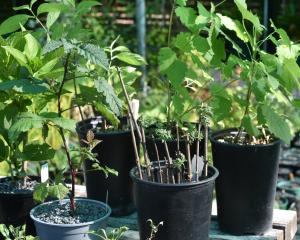Ben Elms, aka Dr Compost, has a little bit of advice for those who are looking for a quick and easy way to compost food scraps.
In our work helping householders to reduce and remove their food scraps from the waste stream, we come across different composting systems; some good, some not so good.
We don't need to get into the whys of getting compost out of the rubbish or sink, more the why nots: those food scraps are a massive resource going down the gurgler.
They should be utilised in some way in our gardens.
Finding an easy solution that isn't in the rocket science arena is what we all want when it comes to composting.
Often it's not about one solution but a multitude of systems to deal with your situation. You may have a cold compost heap and a worm farm.
Or a set of Bokashi buckets and a cold compost heap. Some households may have all three, harnessing all those scraps and green clippings into free fertiliser for the garden.
If you're looking for a quick and easy way to compost food scraps and/or need to add fertility to your garden, the Bokashi Bucket system could be for you.
Originating from old-world farmers in Japan, this type of composting system is now being used all over the world.
Christchurch company ZingBokashi has been pioneering this system in New Zealand for 14 years. It has developed a double-bucket system which is made in New Zealand.
This has resulted in a system that is very affordable compared to setting up a worm farm or a green cone.
All you do is put your food scraps into the bucket once a day, and sprinkle some bioactive bokashi dust over the food scraps.
You can keep the buckets in the kitchen, as they don't smell, which means no more walks out to the compost heap in the dark or the rain.
Make sure you have closed the lid afterwards, as it's important to keep the buckets airtight. Compost-zing is the name of the bioactive dust that pickles your food waste.
It is inoculated with EM (effective micro-organisms), containing about 70 different dormant bacteria just waiting to get to work on your food scraps. What's happening is the bacteria in the bioactive dust are fermenting your food scraps.
As you fill the bucket up, some liquid may drain out into the bottom bucket. Remove it every couple of days, dilute the liquid and use it on your garden. It's full of beneficial micro-organisms which will give your plants a boost.
Once your bucket is full, put it aside for up to week (depending on the time of year) in a place with a mild temperature, e.g. a garage.
The food scraps will not turn into compost in the bucket, in fact when you bury them in the ground, the food scraps will look much the same but with a yellowish tinge.
This is all good as the rapid composting occurs once the contents are buried in the ground.
To use the fermented food scraps, just dig a hole in the vege garden or the tunnel/glasshouse, next to a tired rose or a hungry apple tree. You put the contents of the bucket directly where you need the fertility.
The contents break down in the ground and this is where they stay. A great side-benefit is the massive population of worms that will arrive from nowhere to feast on your bokashi food scraps.
Dr Compost (aka Ben Elms) gives advice and runs workshops to encourage home composting and reduce waste, funded by Queenstown Lakes District Council.
He will be running a free Get Composting workshop today, 10am-midday at the Gorge Rd council office in Queenstown.
Tips
- It's good to have two sets of buckets. So when one set is full and resting, you can be filling the second set in your kitchen.
- Only open the bucket once a day to put your food scraps in. Keep a bucket or ice-cream container on the bench, and add the food scraps to your Bokashi bucket at the end of each day. Make sure that lid is on tightly. There are anaerobic processes at work. The less the lid is open the better your results.
- Take off the liquid that is caught in the bottom bucket every couple of days and use immediately. Uses include diluting in a watering can and feeding your veges. Or use as a foliar spray (dilute 200:1). Use on heavy feeders, tired and diseased plants or trees in the garden for great results.
- The liquid becomes putrid (and smelly) if left in the bucket too long.
- You can flush the liquid down the toilet into a septic tank, or down a shower/sink/toilet to introduce some beneficial bacteria into your pipes.
- When you empty your fridge and find new life forms in the back, don't be tempted to put them in the bucket. You don't want to introduce any unfriendly bacteria as they can hijack the process.
- In the depths of winter, empty the bucket into the middle of a compost heap and cover. Better still, keep burying it in your glasshouse all winter long. Your glasshouse will hit spring running.
Get one
Go to www.zingbokashi.co.nz or visit the Queenstown Lakes District Council or Dunedin City Council, which both sell Bokashi buckets at wholesale rates (approximate cost is $74 for two systems and one bag of the bioactive dust (compost-zing). Replacement bags are available for $6 a bag).











